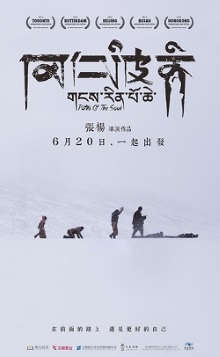
This is a Tibetan film that I first read about in The Economist but I would have heard of it nevertheless due to how it has been making waves in film festivals all over the world. It was made by Chinese director Zhang Yang but judging from its credits and title cards which are in English, this seemed to have been made mostly for an international audience.
In a village of ethnic Tibetans, an aging man Yang Pei grouses about how his brother died without fulfilling his lifelong wish of making a pilgrimage to Lhasa and hopes that the same thing won’t happen to him. His nephew Nyima feels obliged to organize the arduous trip for him. When the other villagers hear about his plans, more and more ask to join in for reasons of their own. One for example represents a family who had two workers get accidentally killed while building a house and wishes to make up for it. Another wants to expiate his sin from slaughtering yaks for a living. A pregnant woman and a little girl even joins in. Then the pilgrimage gets underway and we learn that it involves a grueling, months long journey on foot in which the participants have to throw themselves onto the ground every few steps to kowtow. A tractor pulling a wagon helps them carries their supplies and the tents they need for the journey but they still have to contend with bad weather, accidents and other forms of adversity.
This film straddles the line between a work of fiction and a documentary. The objective distance between the camera and the characters encourages you to think of it as a documentary. Every detail, no matter how tiny is included, beginning with a fascinating shot of how a household comes awake in the morning. At the same time, there’s a bit too much drama over the course of the journey and it’s implausible that the director was just conveniently around as it happened. Still between such events as a baby being born during the pilgrimage and the group coming across a small landslide, the film feels chillingly real and that makes the obvious hardship and suffering that the group undergoes a very concrete thing. The cinematography is superb and the grand landscapes that they slowly trudge across only reinforces the awesome scale of the task that they have undertaken.
I am of course an atheist but the sheer intensity of the religious devotion on display here transcends personal beliefs. Watching them throw themselves onto the ground again and again and again sounds like it should make them look stupid but the matter of fact manner that they do it and how faith is such a foundation of their everyday lives makes it look sobering instead. It is simply impossible to think ill of them. I especially liked the scene when they meet with an elderly man who castigates them for walking too many steps between kowtows and wearing red while on pilgrimage. It sounds like every religious zealot ever except that he takes the sting out of it by inviting them to stay at his house and gifts them a leather apron that is needed to protect the body from abrasion with the ground. This pattern repeats across the many people they meet on the way who variously praise their devotion and express envy that they are unable to join the pilgrimage. As someone unfamiliar to Tibet it is impossible to judge how true this depiction is, but this sense of the entire society that takes religion so seriously is a powerful one.
Naturally we all know how religion can also be coercive even if this aspect is never shown in this film. The worst that we see is when one character grouses about how unfair it is that ill luck happens to him when he has done nothing wrong. All the same, watching volunteers put themselves through this harrowing trial is itself a moving experience. This extreme sacrifice of personal effort, time and even material resources for the sake of their faith can’t help but stir one’s spirits. I would never agree with the value of such practices but this film does help me sympathize with why some people feel such a need for it. For this reason, watching this film is a moving and even enlightening experience.
Yes it is true depiction. All temples, especially the Potala Poalce in Lhasa has throng of masses doing the same ritual in a circuit from sunup to sundown everyday. Talking about leather apron brings back memories.
Religion do not have to be about a personal God, it can be for something larger than oneself
oops Potala Palace I mean.
Pretty cool that you have first hand impressions of this. Must have been a fascinating trip.